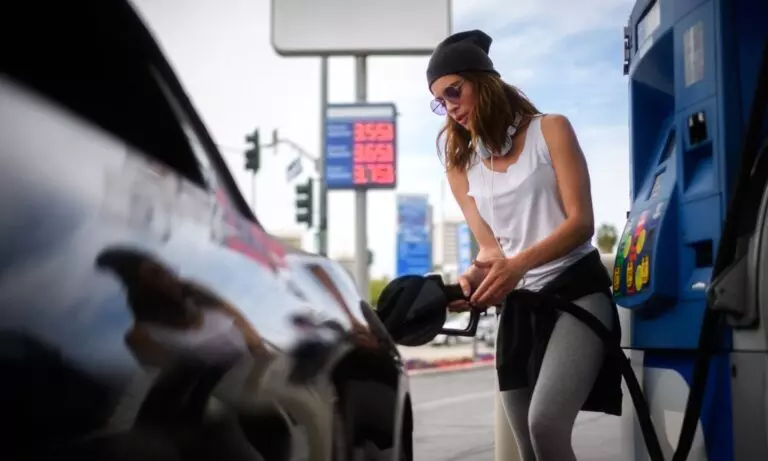As of November 14, the average U.S. regular gas price was $3.773 per gallon according to AAA which tracks gas prices.
Are gas prices falling? It depends on how you compare current prices.
It is much more affordable than some of this year’s prices. According to AAA data, the average regular gas price on November 14 was about 3 cents less than the previous week’s but 13 cents less than one month ago.
A sharpest price drop can be seen when you compare the current average with peak prices. This is a nearly 25% decrease since June 2022, when the average was $5.006/gallon according to the U.S. Energy Information Administration or EIA.
AAA data also shows that the current cost of a vehicle is 32 cents less expensive than the price at the same time last years, which was in November 2021. This is a cost increase of almost 11 %.
Where is America’s highest gas price?
The states below have the highest average gas prices per gallons, according to AAA data from Nov. 14.
-
California: $5.433
-
Hawaii: $5.200
-
Nevada: $4.999
-
Washington: $4.804
-
Oregon: $4.791
Why is California’s gas prices so high?
Californians are the most likely to pay the highest gas prices. This is due to several factors, including:
-
High gas taxes: $0.539 according to IGEN (a tax software company).
-
Higher fuel mix required to meet state emission standards.
-
A decline in investment in state refining has been sparked by a state mandated phaseout of gasoline-powered cars and high carbon capandtrade fees.
Where is the lowest gas price?
The following states have the lowest average gas prices per gallons as of Nov. 14 according to AAA data:
-
Texas: $3.110
-
Georgia: $3.167
-
Mississippi: $3.204
-
Arkansas: $3.233
-
Louisiana: $3.278
How does gas prices work?
A complex set of factors determines the price of gasoline.
Consumer sentiment about the economy and gas prices are closely related, according to the Mercatus Center of George Mason University in Virginia. As gas prices rise, so does consumer confidence.
Learn more about gas prices:
There are four types available at the pump, each with a different price. There are three types of non-diesel gasoline: regular, premium, and midgrade. They are classified by octane ratings, which is a measure for fuel stability. This refers to the pressure at which fuel will ignite in an engine ).
-
Regular: The cheapest.
-
Super or Midgrade: Less expensive than regular, but more affordable than diesel and premium.
-
Premium or Super Premium: The most expensive non-diesel gasoline.
-
Diesel, also known by distillate fuel oil is used in diesel-powered vehicles, such as buses and freight trucks. Diesel is the most expensive fuel available on the retail marketplace.
The price of gasoline at your local station is dependent on multiple costs and profits, including
The majority of gasoline sold in America is produced here. To produce gasoline, crude oil must first be refined. The crude oil used in the U.S. to make gas is a mixture of domestic and imported oil. Canada, Mexico and Saudi Arabia are the main sources of crude oil imported into the United States. Russia was included on this list from March 2022 to March 2022 before the conflict in Ukraine.
The U.S. can sometimes source its oil from abroad, which means that we have lower fuel costs than countries like Europe, where most of the crude oil is imported. However, crude oil used in gasoline production in the U.S. cannot be entirely sourced from there. This can impact the price of fuel at your local station.
To make fuel that can be used to transport crude oil, it must be refined. This is done in petroleum refineries. Refining costs change throughout the year, and vary by region. This cost depends on the crude oil used, the ingredients used to make the fuel, the formulation required in each region to meet the air quality standards and the technology used at each refinery.
Federal, state, and local taxes also affect the retail price of gasoline. Federal taxes on gasoline are 18 cents per gallon for gasoline and 24 cents for diesel.
There are also tax rates for each state. According to the U.S Energy Information Administration (EIA), gas taxes and fees in total cost 31.02 cents per gallon. According to IGEN, the following states have the highest fuel tax rates:
-
Pennsylvania: $0.576.
-
California: $0.539.
-
Washington: $0.494.
-
New Jersey: $0.421.
-
Illinois: $0.392.
In 2022, multiple states granted gas tax holidays to their drivers to give them some relief.
Distribution, marketing, and retailers
Gas prices are also affected by the cost and profit of transporting fuel to consumers. After crude oil has been refined into gasoline, it is transported via pipeline to terminals. There it can be mixed to meet local standards. It is then transported via tanker truck from terminals to the retail gas stations, where it can be blended to meet local standards. Consumers will also be charged for the marketing and operational costs of independent stations or chains. The price that gas retailers charge will be affected by rent, traffic patterns and wages, as well as insurance, taxes, and other operational fees.
Can the president regulate gas prices?
The president does not set the prices at the pump. Don’t blame the president if prices rise. On the other hand, don’t blame the president if prices fall.
Although the White House is frequently blamed for the rise in gasoline prices, the administration has very few tools that can move the needle. The problem is supply and demand.
